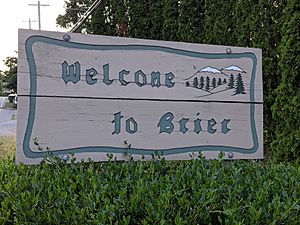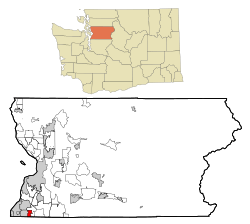Brier, Washington facts for kids
Quick facts for kids
Brier, Washington
|
|
|---|---|
 |
|

Location of Brier, Washington
|
|
| Country | United States |
| State | Washington |
| County | Snohomish |
| Founded | 1883 |
| Incorporated | February 11, 1965 |
| Government | |
| • Type | Mayor–council |
| Area | |
| • Total | 2.20 sq mi (5.69 km2) |
| • Land | 2.20 sq mi (5.69 km2) |
| • Water | 0.00 sq mi (0.00 km2) |
| Elevation | 420 ft (128 m) |
| Population
(2020)
|
|
| • Total | 6,560 |
| • Estimate
(2022)
|
6,463 |
| • Density | 3,173.95/sq mi (1,225.24/km2) |
| Time zone | UTC-8 (Pacific (PST)) |
| • Summer (DST) | UTC-7 (PDT) |
| ZIP code |
98036
|
| Area code | 425 |
| FIPS code | 53-07940 |
| GNIS feature ID | 1512029 |
Brier is a small city in Snohomish County, Washington, United States. It is located near other cities like Mountlake Terrace and Bothell. In 2020, about 6,560 people lived there.
Contents
History of Brier
Brier is built on land that was once home to several Coast Salish Native American groups. These included the Sammamish, Snohomish, and Suquamish peoples. The area around Swamp Creek was called dxʷɬ(ə)q̓ ab in their Lushootseed language. This name meant "other side of something" and "a wide place."
Early Settlers and Development
The first European settlers arrived in Brier in 1883. The Salty family came from Finland and built a cabin. They were followed by loggers who cleared the forests. The first school in the area was built in 1896. It was later replaced by the Cedar Valley School in 1911. By 1915, most of the forests around Brier had been cleared.
In the past, Brier was known for its mink farms. Later, in the 1950s and 1960s, many suburban ranch houses were built. A housing area called Shasta Park was started in 1924. It was further developed into smaller lots by the early 1950s. The city was named after an existing road that went through this new community.
Becoming a City
Brier officially became a city on February 11, 1965. This happened after a quick vote. A developer had suggested that the area join nearby Mountlake Terrace. Boeing engineer Richard Balser became Brier's first mayor. The first city hall was in a room rented from a local resident.
Within ten years, Brier grew to have about 1,000 more residents. The city opened its own permanent city hall and public library in 1974. A city park also opened in 1976 as part of the national bicentennial celebrations. Brier continued to grow into a suburban community, reaching over 6,000 people by 1999. A new city hall building opened in April 2005.
Geography of Brier
Brier is located about 15 miles (24 km) north of Seattle. It is in the southern part of Snohomish County. To the south, it borders Lake Forest Park in King County. The cities of Mountlake Terrace are to the west, and Bothell is to the east. A road called Brier Road connects the northern part of the city to Lynnwood.
The city covers an area of 2.13 square miles (5.52 square kilometers), all of which is land. Brier is known for having large lots for homes. Homes must be built on lots that are at least 12,500 square feet (1,160 square meters). The city is only zoned for single-family homes.
Economy in Brier
Brier is a small city with very few businesses. It is sometimes called a "one-store and one-restaurant town." Most of the businesses are located on its main commercial street.
Population and People
| Historical population | |||
|---|---|---|---|
| Census | Pop. | %± | |
| 1970 | 3,093 | — | |
| 1980 | 2,915 | −5.8% | |
| 1990 | 5,633 | 93.2% | |
| 2000 | 6,383 | 13.3% | |
| 2010 | 6,087 | −4.6% | |
| 2020 | 6,560 | 7.8% | |
| 2022 (est.) | 6,463 | 6.2% | |
| U.S. Decennial Census | |||
Brier is considered one of the wealthier areas in Washington state. This is based on its per person income. It ranks 68th out of 522 areas in the state.
Brier's Population in 2010
According to the 2010 U.S. census, there were 6,087 people living in Brier. These people lived in 2,165 households, with 1,758 of them being families. The city had about 2,858 people per square mile (1,103 per square kilometer).
Most of the people in Brier were White (84.9%). There were also people of Asian (7.6%), African American (1.1%), Native American (0.5%), and Pacific Islander (0.2%) backgrounds. About 4.3% of the population identified as two or more races. Hispanic or Latino people made up 4.0% of the population.
In Brier, 35.4% of households had children under 18. Most households (71.0%) were married couples living together. The average household had 2.81 people, and the average family had 3.05 people. The average age in the city was 44.4 years. About 21.4% of residents were under 18 years old.
Culture and Community
Brier has a special annual event in August called SeaScare. This name is a fun play on Seattle's Seafair event. SeaScare includes a Porch Light Parade, contests, music, and a classic movie screening. It often has nautical (boat-related) themes, connecting to its Seafair ties. Local businesses help support this community event.
Brier Public Library
Brier is part of the Sno-Isle Libraries system. This system runs public libraries in Island and Snohomish counties. Brier's permanent city library opened in November 1974. Before that, a bookmobile service brought books to residents.
In 1995, Brier residents voted to approve a 20-year bond issue. This money helped build a new library with more books and computers. The new library building opened on May 3, 1996. It has 2,980 square feet (277 square meters) of space.
Education in Brier
Most of Brier is served by the Edmonds School District. This district manages public schools for much of South Snohomish County. It includes schools in Edmonds, Lynnwood, Mountlake Terrace, and Woodway. The district has 41 schools and over 20,400 students.
The Edmonds School District has one elementary school and one middle school located within Brier. high school students living in Brier usually attend Mountlake Terrace High School. A small part of the southeastern corner of Brier is in the Northshore School District. This district also serves Bothell and Kenmore.
City Infrastructure
Transportation in Brier
Brier is located between two major highways: Interstate 5 to the west and Interstate 405 to the east. You can reach these highways through Mountlake Terrace and Bothell. Brier has 28.5 miles (45.9 km) of local roads. Most of these are residential streets with low traffic. The city does not have any state routes or railroads.
Community Transit operates one bus route through Brier. This route connects to Mountlake Terrace station, which is a Link light rail station and bus hub. The bus runs during busy peak hours. There is also a park-and-ride lot along the bus route. In September 2024, King County Metro launched a new on-demand microtransit service called Metro Flex in Brier and nearby areas.
Utilities and Services
The Alderwood Water and Wastewater District provides water and wastewater services to Brier. The district gets its tap water from the City of Everett's system. This water comes from Spada Lake.
See also
 In Spanish: Brier (Washington) para niños
In Spanish: Brier (Washington) para niños

